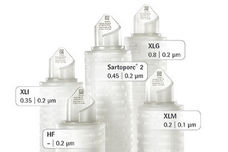Environmentally friendly Filter membrane renders viruses harmless
New filter membrane is highly efficient at filtering and inactivating a wide variety of air-borne and water-borne viruses: ETH spin-off holds the patent on this new technology
viruses can spread not only via droplets or aerosols like the new coronavirus, but in water, too. In fact, some potentially dangerous pathogens of gastrointestinal diseases are water-borne viruses.

A new filter membrane removes viruses from the water and makes drinking water safe (symbolic image)
pixabay.com
To date, such viruses have been removed from water using nanofiltration or reverse osmosis, but at high cost and severe impact on the environment. For example, nanofilters for viruses are made of petroleum-based raw materials, while reverse osmosis requires a relatively large amount of energy.
Environmentally friendly membrane developed
Now an international team of researchers led by Raffaele Mezzenga, Professor of Food & Soft Materials at ETH Zurich, has developed a new water filter membrane that is both highly effective and environmentally friendly. To manufacture it, the researchers used natural raw materials.
The filter membrane works on the same principle that Mezzenga and his colleagues developed for removing heavy or precious metals from water. They create the membrane using denatured whey proteins that assemble into minute filaments called amyloid fibrils. In this instance, the researchers have combined this fibril scaffold with nanoparticles of iron hydroxide (Fe-O-HO).
Manufacturing the membrane is relatively simple. To produce the fibrils, whey proteins derived from milk processing are added to acid and heated to 90 degrees Celsius. This causes the proteins to extend and attach to each other, forming fibrils. The nanoparticles can be produced in the same reaction vessel as the fibrils: the researchers raise the pH and add iron salt, causing the mixture to “disintegrate” into iron hydroxide nanoparticles, which attach to the amyloid fibrils. For this application, Mezzenga and his colleagues used cellulose to support the membrane.
This combination of amyloid fibrils and iron hydroxide nanoparticles makes the membrane a highly effective and efficient trap for various viruses present in water. The positively charged iron oxide electrostatically attracts the negatively charged viruses and inactivates them. Amyloid fibrils alone wouldn’t be able to do this because, like the viral particles, they are also negatively charged at neutral pH. However, the fibrils are the ideal matrix for the iron oxide nanoparticles.
Various viruses eliminated highly efficiently
The membrane eliminates a wide range of water-borne viruses, including nonenveloped adenoviruses, retroviruses and enteroviruses. This third group can cause dangerous gastrointestinal infections, which kill around half a million people – often young children in developing and emerging countries – every year. Enteroviruses are extremely tough and acid-resistant and remain in the water for a very long time, so the filter membrane should be particularly attractive to poorer countries as a way to help prevent such infections.
Moreover, the membrane also eliminates H1N1 flu viruses and even the new SARS-CoV-2 virus from the water with great efficiency. In filtered samples, the concentration of the two viruses was below the detection limit, which is equivalent to almost complete elimination of these pathogens.
"We are aware that the new coronavirus is predominantly transmitted via droplets and aerosols, but in fact, even on this scale, the virus requires being surrounded by water. The fact that we can remove it very efficiently from water impressively underlines the broad applicability of our membrane," says Mezzenga.
While the membrane is primarily designed for use in wastewater treatment plants or for drinking water treatment, it could also be used in air filtration systems or even in masks. Since it consists exclusively of ecologically sound materials, it could simply be composted after use – and its production requires minimum energy. These traits give it an excellent environmental footprint, as the researchers also point out in their study. Because the filtration is passive, it requires no additional energy, which makes its operation carbon neutral and of possible use in any social context, from urban to rural communities.
In addition to Mezzenga’s laboratory, scientists from several Swiss universities were involved in the work, including virus specialists from the Universities of Zurich, Lausanne and Geneva, EPFL, the University of Cagliari and the ETH spin-off BluAct, which holds the patent on this new technology.
Original publication
Other news from the department science
These products might interest you
Most read news
More news from our other portals
Something is happening in the life science industry ...
This is what true pioneering spirit looks like: Plenty of innovative start-ups are bringing fresh ideas, lifeblood and entrepreneurial spirit to change tomorrow's world for the better. Immerse yourself in the world of these young companies and take the opportunity to get in touch with the founders.






























































